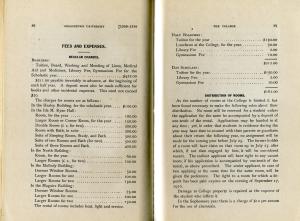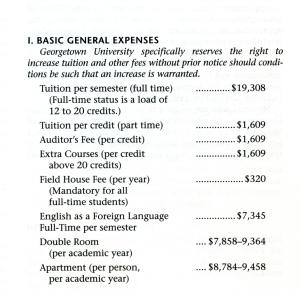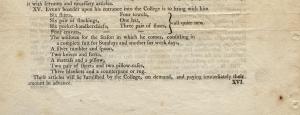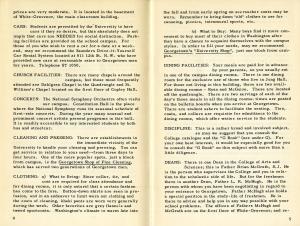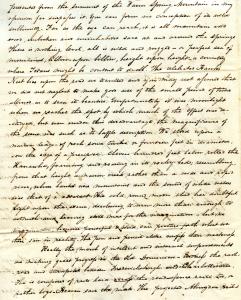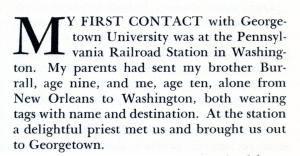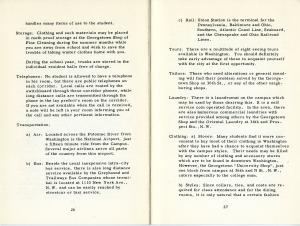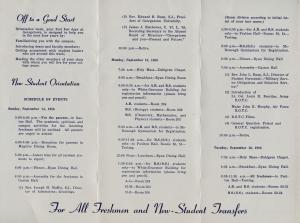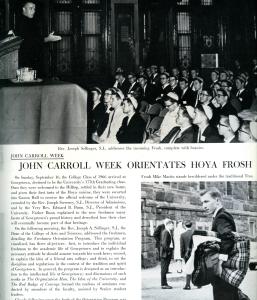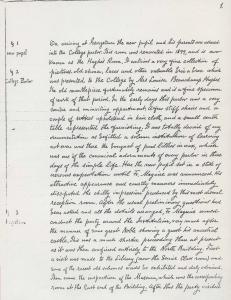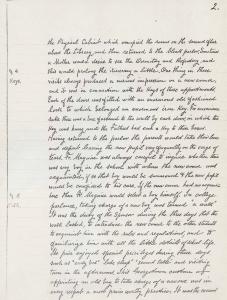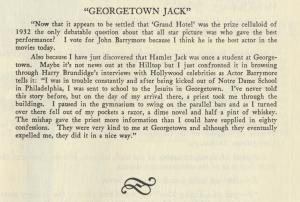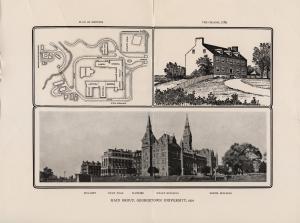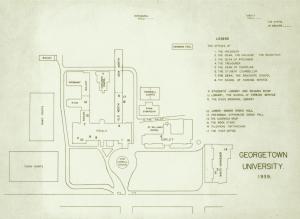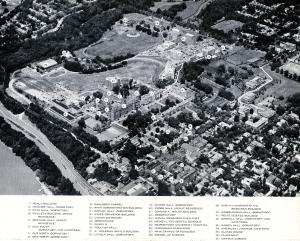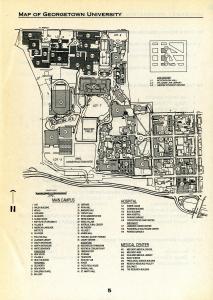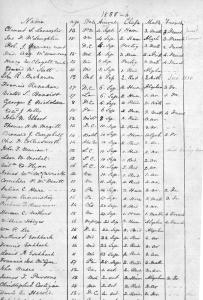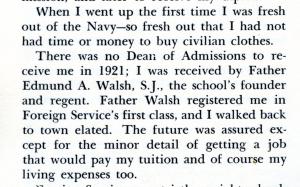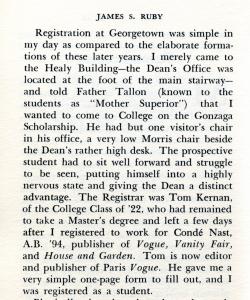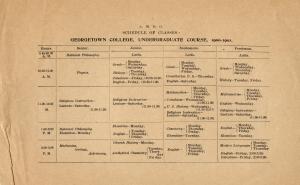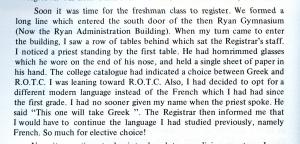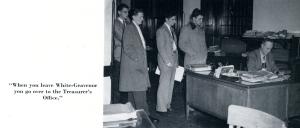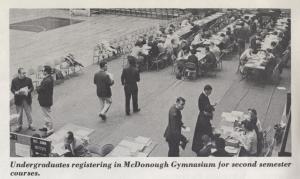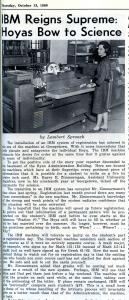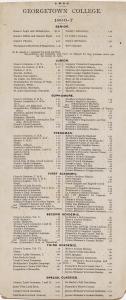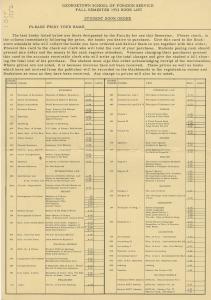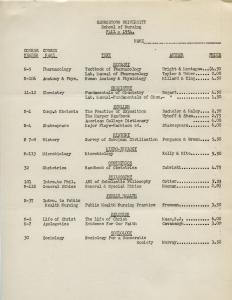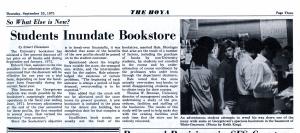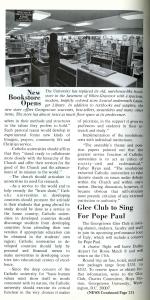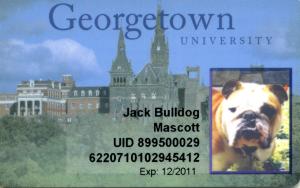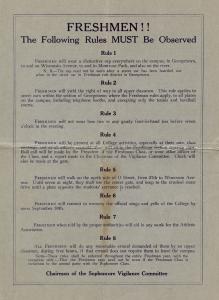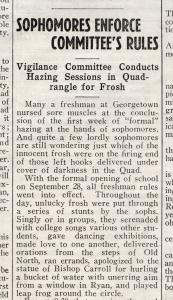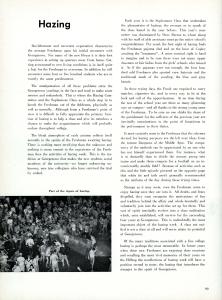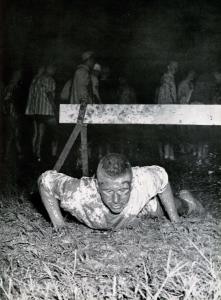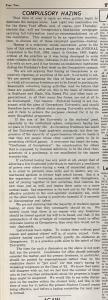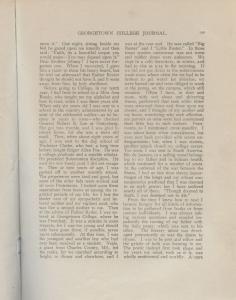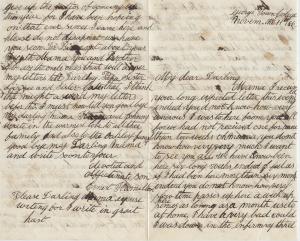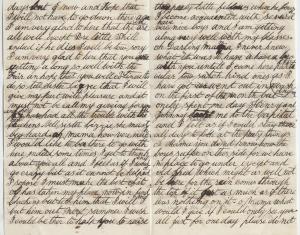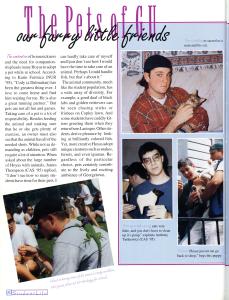An Exhibition from the Georgetown University Archives
Since 1791 and Billy Gaston’s arrival from North Carolina, new students come to campus each year having navigated fee payments and packing lists and figured out travel plans. And once here, they begin the process of adapting to campus life. This exhibition highlights a selection of documents in the University Archives on the topic of coming to the Hilltop.
Fees
Traditionally, Jesuits did not charge tuition in their schools. Georgetown was the exception to this practice until 1827, when the Order’s Superior General in Rome explicitly ruled that it should cease collecting tuition. Students were, however, still charged for board and lodging. In 1833, after a formal request for dispensation from the ban on charging tuition was granted by Rome, Georgetown College was able to collect tuition payments once more.
What to pack?
The University has always given guidance, sometimes not followed, on what students should bring with them. This guidance has obviously evolved over time.
“Clothing: a) What to Bring.” Georgetown and You [student handbook sponsored by the Student Council of the College of Arts and Sciences], 1951-1952
Travel to campus
Letter from H.H. Strawbridge to Joshua Ritchie, September 6, 1837
Travel to and from campus in the 18th and 19th centuries could be a difficult and multi-day affair. The potential issues involved can be seen in this letter describing a trip home from campus to Louisiana. Written by student H[enry] H. Strawbridge on September 6, 1837 from Covington, Louisiana, to Joshua A. Ritchie at Georgetown, Strawbridge describes how he left D.C. on August 9 and arrived in New Orleans on September 3, having traveled first by road and then by boat between Cincinnati and New Orleans.
Account of traveling from New Orleans to Washington, D.C. in 1890 by W.W. Hoffman. Extract from an essay in On the Hilltop: Reflections and Reminiscences by Georgetown Alumni, 1966
By the late 19th century, improvements in train travel made movement between New Orleans and Washington, D.C. easier, although to 21st-century sensibilities, the placement, as described in this account, of two young children by themselves on a train in New Orleans is a little shocking. The Georgetown Preparatory School was still based on campus at this time, which explains the youthfulness of the Hoffman brothers.
Transportation section of Georgetown and You [student handbook sponsored by the Student Council of the College of Arts and Sciences], 1956-1957
Orientation to campus
New Student Orientation schedule of events, 1958
An official New Student Orientation process seems to date to the 1950s. Shown here is the earliest NSO schedule which has been identified in the University Archives.
Pages 1 and 2 of “Student Life at Georgetown in the Late [Eighteen] Sixties” by Francis A. Barnum, S.J., C’1871
In the mid-19th century, the process of orienting new students and their parents to campus involved a tour given by the University president. If a new student did not already know any students, the President would select one whose role it was to introduce the new student to other students, acquaint him with the rules and regulations and familiarize him with all the little details of school life. This process, known as “a walk”, lasted three days.
“Georgetown Jack.” Georgetown College Journal, February 1933
John Barrymore, the well known stage and screen actor, recalled his tour of campus as a new student in an interview reprinted in the February 1933 issue of the Georgetown College Journal. In view of his references to whiskey, it should be noted that he was 13 years old when he enrolled as a student in Georgetown’s Preparatory School in 1895.
Campus maps, 1910, 1939, 1970, and 2000
An essential tool for any new student is a campus map. Here are examples reflecting significant expansion of physical plant on campus over a 90-year span. The current campus map can be viewed here.
Registration/Class Assignment
Enrollees, 1855-1856. As recorded in the Entrance book, 1850-1894
Students enrolling at Georgetown in the 19th century did no go through a registration process. Rather, information about them (such as age, religion, class placement, and father’s name and address) was recorded chronologically in a series of ledgers known as entrance books.
Seen at the bottom of this entrance book page is the entry for David Herold, who enrolled on October 4, 1855, aged 13. He attended Georgetown until 1858 and was one of four conspirators hanged for involvement in the assassination of President Abraham Lincoln in 1865. This involvement may explain the later addition in an unknown hand of the faintly penciled word "Alas!" after Herold's name - presumably written to convey dismay that he was included in this or any record of Georgetown students.
Registration memories of Willard Beaulac, F’1921 (left) and James Ruby, C’1927 (right). Extracts from essays in On the Hilltop: Reflections and Reminiscences by Georgetown Alumni, 1966
Even into the 20th century, the admissions/registration process on campus was relatively straightforward, as these accounts reflect.
1900-1901 Class Schedule, reflecting no electives (left). First mention of an elective in the University’s catalog, 1906 (right)
Until 1906, the process of registering and selecting classes was simplified by the fact that there was a prescribed curriculum which included no electives.
Account of registration in 1927. In The Hilltop Remembered by William G. McDevitt
After electives were introduced, however, signing up to take them was not always a straightforward matter as William McDevitt , C’1931, G’1932, M’1936, recounts in his memoirs, The Hilltop Remembered, which trace his time as a Georgetown student between 1927 and 1936.
Registration as pictured in Ye Domesday Booke, 1951 (left) and Georgetown Record 1962 (right)
“IBM Reigns Supreme: Hoyas Bow to Science.” The Hoya, October 13, 1969
Computers were used at registration for the first time in the fall semester of 1969.
Buying textbooks
“New Bookstore Opens.” Georgetown Today, November 1973
The campus bookstore has had a number of homes, including Old North, Healy Hall, Poulton Hall, and White-Gravenor. In 1973, it moved from White-Gravenor to the lower level of Lauinger Library and from there into the Leavey Center, where it opened in 1988.
ID cards
The Hoya, November 11, 1948
ID cards were issued to resident students for the first time in fall 1948.
“Mechanized ID System Finally Ready.” Georgetown Voice, September 16, 1975
In fall 1975, new ID cards were issued which could provide access to 22 campus buildings.
The following year, a universal ID card was instituted which could be used to check materials out of the Library, access buildings and pay for meals.
GOCard for Jack, Sr.
The Georgetown One Card, a form of identification allowing students to pay for nearly all on-campus expenses with a single card, was introduced to Main Campus in the 2001-2002 academic year, having been first implemented at the Law Center.
The GOCard pictured belonged to Jack, Sr., who served as Georgetown’s mascot from 2003-2012 and is, to date, the University’s longest serving bulldog mascot.
Hazing
Freshmen rules, 1919
Hazing activities seem to have begun on campus in earnest after WWI. Freshman were subjected to a variety of indignities: they had to wear distinctive blue and gray caps (beanies) even off campus, carry cigarettes for upperclassmen, stand to attention when addressed by them, shine shoes, polish the John Carroll statue with a toothbrush, and know the words the Alma Mater. Infractions to the “Freshman Rules” were punishable by being covered with flour and water or lipstick.
“Sophomores Enforce Committee’s Rules: Vigilance Committee conducts Hazing Sessions in Quadrangle for Frosh.” The Hoya, October 7, 1936
“Compulsory Hazing.” The Hoya, March 20, 1958
Hazing on campus seems to have peaked in the late 1940s. In March 1958, The Hoya called for an end to compulsory hazing and that fall authorities ended hazing early, concerned about the danger of activities.
Homesickness
Portion of a letter from journalist and poet James R. Randall (enrolled 1848-1856), recalling spartan conditions and his homesickness when he was sent to Georgetown at the age of nine. Printed in the Georgetown College Journal, December 1906
For some students, adjustment to campus life is hard; and for many early Georgetown students, as this letter illustrates, spartan conditions intensified feelings of homesickness.
. . . We slept in a cold dormitory, in winter, and had to rise at 5.15 in the morning. If we did not get down to the subterranean wash-room where often the ice had to be broken to get water for ablution, we were barred out and obliged to wash at the pump, on the campus, which still remains. Often I have, in sleet and snow with wet shoes and shivering frame, performed that task while bitter tears streamed down and froze upon my checks, and I thought of my mother and my home, wondering why such affectionate parents as mine had condemned their little boy to such torture. Pneumonia . . . came speedily . . .
Randall was born in Baltimore, Maryland in 1939. He was enrolled at Georgetown from 1848-1856. A journalist and poet, he is probably best known as author of the words to Maryland, My Maryland, which became known as The Marseillaise of the Confederate cause. Maryland, My Maryland served as the state song of Maryland between 1939 and 2021, when its state song status was repealed by the General Assembly.
Letter from homesick student [George] Ernest Hamilton to his mother, Mary Emily Hawkins Hamilton, in Port Tobacco, Maryland, November 11, 1865
. . . Oh Mama, you do not know how very very much I want to see you all. We have been here six long weeks, indeed I feel as if I had been here more than six months, indeed you do not know how very slow time passes up here a week up here semes as long as a month use to at home . . . sometimes I get to thinking about you all and I feel as if I would go crazy but as it cannot be helped I sopose I must make the best of it . . .
The plaintive note sounded in this letter, as well as the creative spelling and punctuation, are perhaps explained by Hamilton’s age (he was only 11). He did, however, persevere, and “make the best” of his Georgetown experience, graduating from the College in 1872 and from the Law Department in 1874. He later served as Law School Dean from 1900 to 1903 and again from 1914-1943.
Reference to the unhappy lot of the new boy to feel homesick at first in “De Quibusdam Rebus,” Georgetown College Journal, vol. 10, no. 2 (November 1881)
Curated by Lynn Conway, Georgetown University Archivist.


